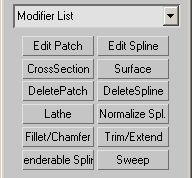Lathe : Modifier
| Value > MAXWrapper > Modifier > Lathe |
Determines the number of degrees that the object is spun around the axis of revolution (0 to 360, default=360).
You can set keyframes for Degrees to animate the circular growth of a lathed object.
The Lathe axis auto-sizes itself to the height of the shape being lathed.
When on, simplifies the mesh by welding together vertices that lie on the axis of revolution.
Depending on the direction of the vertices on your shape, and the direction of rotation, the lathed object might be inside out. Toggle this value to fix this.
Determines how many interpolated segments are created in the surface between the start and endpoint.
Caps the start of the lathed object with Degrees set to less than 360 and a closed shape.
Caps the end of the lathed object with Degrees set to less than 360 and a closed shape.
0-Morph (Arranges cap faces in a predictable, repeatable pattern necessary for creating morph targets. Morph capping can generate long, thin faces that don’t render or deform as well as grid capping. Use morph capping primarily if you are lathing multiple morph targets.)
1-Grid (Arranges cap faces in a square grid trimmed at the shape boundaries. This method produces a surface of evenly sized faces that can easily be deformed by other modifiers.)
0-Patch (Produces an object that you can collapse to a patch object.)
1-Mesh (Produces an object that you can collapse to a mesh object.)
2-NURBS (Produces an object that can be collapsed to a NURBS surface.)
When on, applies mapping coordinates to the lathed object.
When Degrees is less than 360, and Generate Mapping Coordinates is turned on, additional mapping coordinates are applied to the end caps, placing a 1 x 1 tile on each cap.
When on, the software assigns different material IDs to the sides and the caps of the lathed object.
Specifically, the sides receive ID 3, and the caps (when Degrees is less than 360 and the lathed shape is closed) receive IDs 1 and 2.
When on, the software uses the material ID values assigned to segments in the object.
When on, applies smoothing to the extruded shape.
At this sub-object level, you can transform and animate the axis of revolution.
Position of the axis of revolution.
Rotation of the axis of revolution.
Scale of the axis of revolution.
Enables/disables the real-world map size option.


